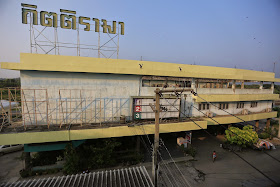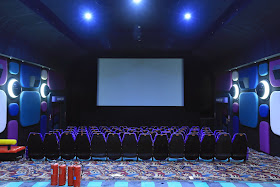The contemporary struggles of independent movie theaters, particularly those of the stand-alone variety, can be summarized in the case of the
Kitti Rama. This bulky 70's-era movie mansion bucked the trend to close for years, outlasting many of its regional counterparts in the process, only to suffer this common fate in the end.
Entrance marquee along the main road. The main body of theater has long been obscured by streetside shop houses.
Roof top view of the Kitti Rama, in all its horizontality.
Many of the syndromes associated with the Kitti Rama's prolonged demise are characteristic of stand-alone movie theaters throughout Thailand, if not the wider world. We won't go into them in detail as they are well documented and somewhat obvious. Television, home-entertainment, the computer, the rise of mall culture, the expansion of suburbia and car culture; this death-by-a-thousand-cuts slowly whittled away the popularity hence profitability of grand, single screen stand-alone movie theaters to the point of near extinction.
The fact that the Kitti Rama weathered the storm for as long as it did is testament solely to the dedication of its owner.
Sawong Loetsuthakul - owner of the Kitti Rama Theater
Sawong Loetsuthakul was born into a family of film exhibitors. Using his inherited knowledge of the cinema business he modified the Kitti Rama to meet changing social and economic patterns. While stand-alone theaters throughout the country were buckling under pressure, Sawong held tight, making the adjustments necessary to survive. In the end, it took an order to cease and desist by a local city inspector to finally end the Kitti Rama's 36 year run.
Columns made to look like trees.
Back in 1978, when the Kitti Rama first opened, it was a 900 seat single screen movie theater on what was then a newly developed section of Chachoengsao. By the time it closed in May of this year it had morphed into a three screen multiplex, one theater outfitted with a brand new digital projection system.
Sawong's father purchased the Kitti Rama from it's original owner shortly after it was built. This was 3rd theater ever in Chachoengsao, also the largest.
Film aside, the Kitti Rama has design features that welcome leisure. Below the stairs in the lower lobby, for instance, is a fish pond, flanked around the edges by smooth concrete benches painted to look like milled wood. The pond, home to a school of metallic colored coy, is a trait that may very well be unique in Thailand to the Kitti Rama. As a landmark within a local landmark, it's easy to imagine movie-goers of the past making the pond a rendezvous point before entering the theater proper. Or, if nothing else, it would have served as a quiet place to escape the golden rays of the sun while awaiting the flicker of the silver screen.
The faux wood benches are matched by nearby columns sculpted and painted to resemble tree trunks. According to Suwong, a local artisan specializing in this type of concrete work was responsible for them. The faux wood columns and benches echo the built environment of old Chachoengsao, which to this day is comprised of ancient wooden houses along the banks of Pakong River and nearby canals.
The Kitti Rama is perhaps the only theater in Thailand's history to have a coy pond in the lobby.
The ticket booth, updated over the years to reflect the more flashy look of modern multiplex theaters.
Beneath the web address of the theater is says "A movie theater for the people of Paed Riw." Paed Riw is the ancient name of Chachoengsao, meaning "8 slices." Its etymological origins are from a legend that the fish living in the nearby waterways are so much bigger than normal that they can be sliced into 8 pieces - "paed riw" - or double the amount of a typical fish.
Mr. Sawong Loetsuthakul really wanted to give his customers a good time. In the lobby area of the theater he had racks of books and magazines for his customers to read while awaiting the start of the movie.
Upstairs in the upper lobby, Sawong left space for a reading nook, along with racks of books and magazines for patrons to peruse. Clearly the man wanted to create a stimulating atmosphere in every way. As glistening new multiplex theaters in nearby shopping malls entered the local market, finding new and creative angles to draw the crowds was a necessity.
Corridor between theaters 1 and 2
Corridor creativity: the design above was achieved by arranging the sides of old pop-corn boxes.
Theater 2
Theater 1
In 1996, Sawong decided to twin the grand single screen auditorium of the Kitti Rama, a measure taken to give movie-goers a greater viewing variety to choose from. Earlier this year, moreover, he opened a 3rd, much smaller auditorium in which he installed a digital projection system.
Since the standard of movie projection has switched from 35 mm film to digital in the last few years, many struggling theaters, unable to afford the expensive new technology, have been forced to close.
Theaters 1 and 2 were not given the digital treatment, thus had to close just as 3 opened.
Fancy, modern, theater 3
With the installation of a digital projection system, Sawong's theater had officially arrived in the 21st century. In May, however, while in the midst of constructing a brand new entrance and ticket counter for the new theater, a state building inspector made a visit. Apparently the materials used in the new auditorium were all considered flammable. The walls were all cloth, the flooring carpet. A fire hazard, it was a labeled. A death trap. Soonthereafter Sawong received an order to cease and desist, finally bringing the grand old theater to its knees.
Dimensional letters and an artificial eagle to scare away pigeons.
The postmortem tour Sawong gave of the Kitti Rama was akin to a parent unveiling the corpse of their own recently deceased child. Just a few months prior he was busy making improvements to a functional movie theater, spending lavishly to compete with the newly arrived multiplex competition. Now his baby is dead.
But like all things that end tragically, the victims must move on or forever languish in the past. Sawong has indeed chosen to move forward, maintain the Kitti Rama as an entertainment venue of a different gauge.
The Kitti Rama's lower lobby has been retrofitted with karaoke rooms.






























